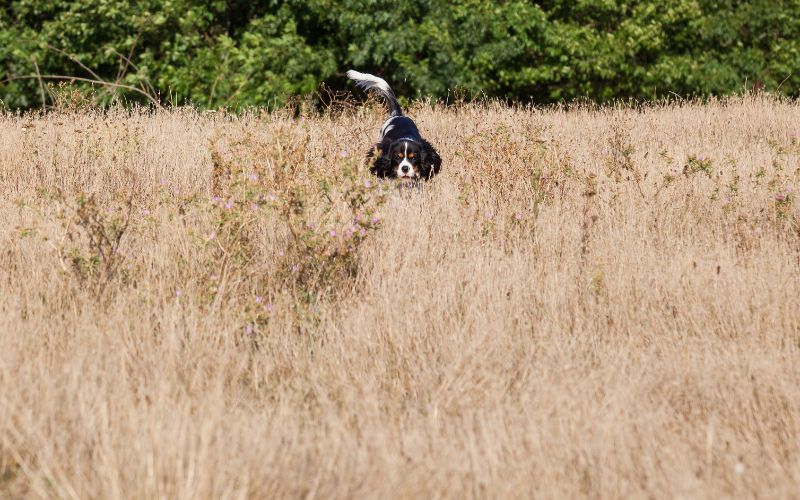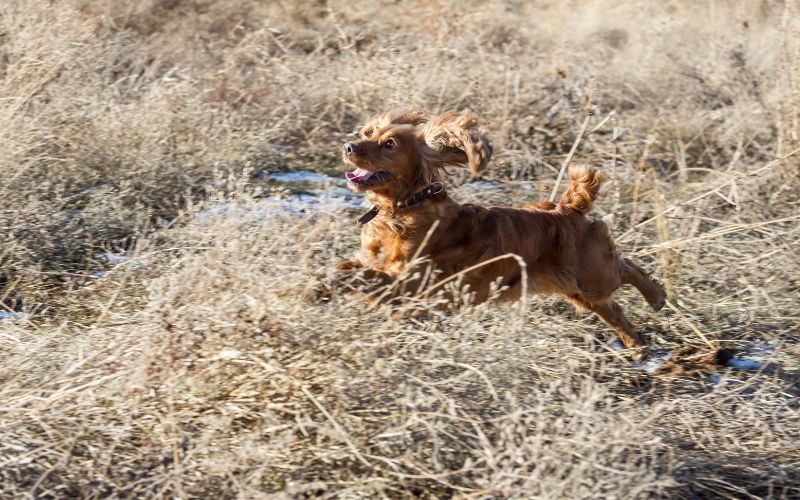There’s no doubt that a well-trained gundog is an essential part of any shooting party.
And one of the most important commands a gundog needs to learn is how to get into cover. T
his can be a challenging task, but with patience and consistency, it’s something that can be taught to any dog.
In this blog post, we’ll discuss the best ways to go about training your dog to get into cover, as well as some of the benefits of doing so.
When teaching a spaniel to get into cover, it’s important to be patient and consistent. You may need to try a few different methods to get your dog interested in entering the cover, but with patience and perseverance, it’s something that can be taught to any dog.
Introduce the command ‘Get In’
When your spaniel puppy is around three to four months old, start taking them for daily walks in an area with rough grass, rushes or thinly distributed bracken.
Lean down and point into the cover, saying the command ‘Get In’.
It’s important to remember that your puppy won’t have much of an idea what you mean so you may need to walk into the cover with him, encouraging him all the time saying ‘ Get in’.
If your puppy likes tennis balls ( and most spaniels do ) try rolling a ball, in full view of him, and let him run after it into the cover.
If your puppy shows a reluctance to enter the cover, you can also try throwing a treat into the cover to attract their attention and encourage them to ‘get in’.
Be patient and consistent
It’s important to be patient when teaching your dog to get into cover.
You may need to try a few different methods before you find one that works for your dog.
With patience and consistency, your dog will eventually learn the command and be able to enter cover when you ask them to.

Encourage your dog’s natural instincts
Gundogs are bred to hunt and retrieve game, so it’s important to encourage their natural instincts when teaching them to get into cover.
Try playing fetch with your dog in the cover, or taking them on a walk in an area with a strong scent of game.
This will help to stimulate their natural hunting instincts and make it more likely that they’ll enter the cover when you ask them to.
Reward your dog
When your dog enters the cover, be sure to give them plenty of praise and rewards.
This will help to reinforce the positive behavior and make it more likely that they’ll do it again in the future.
Practice
As with any new skill, practice makes perfect.
The more you work with your dog on this command, the better they’ll become at entering cover when you ask them to.
Vary the types of cover
I’ve always found that the best cover for a young spaniel is rushes, the type that you see in clumps on moorland.
They are soft, hold scent and are easy for a young dog to get into without hurting him.
Most dogs, even older, experienced ones, do not enjoy entering thick cover such as brambles so, for a youngster, you should make the experience as enjoyable as possible.
Bracken, fallen trees and other types of ‘non prickly’ cover are all ideal places for your young dog to explore.
As he becomes more proficient and confident you can look to move onto denser areas such as gorse and brambles.
Keep it interesting
Spaniels will always enjoy hunting and entering cover is a natural trait for most of them.
However there is always the potential for a dog to ‘get fed up’ or even for a dog to not wish to enter cover at all.
If you find that this happens to you then the trick is to look at the places where you are training and determine if there is anything that you could do to make things more appealing to your dog.
Treats and tennis balls have already been mentioned and you can also use dummies ( canvas or fur ), thrown into the cover as a retrieve.
Other options are to find areas that hold good levels of scent, rabbit is always a good one and there are very few dogs that will not go into cover to check out the scent of a rabbit.
Remember that on hot, dry days scent will be poor so try to plan your training around suitable weather conditions.
Final Words
Teaching your dog to get into cover is a great way to prepare them for future training.
It’s also a valuable skill for any gundog to have, as it’s an essential part of being a successful hunting dog.
With patience and consistency, this is something that can be taught to any dog.
And once your dog has mastered this command, you’ll be able to enjoy many hours of fun and satisfaction out in the field together.




